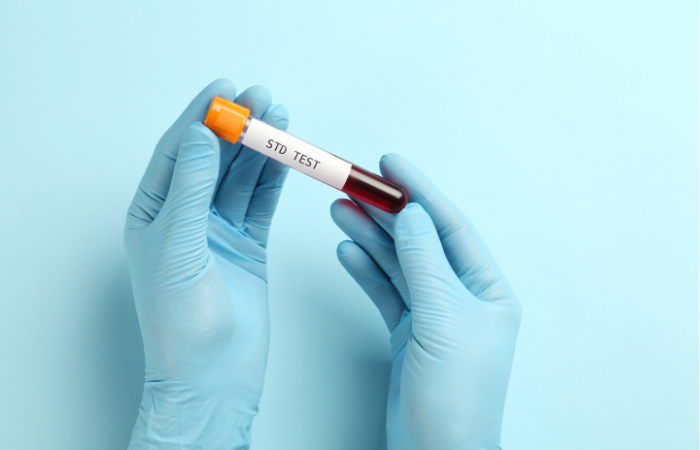STD or UTI? How Discharge and Pain Can Mislead You
What Vulvar Pain Actually Feels Like (And Why That Matters)
Here’s the deal: not all pain “down there” is the same. Some people describe it as a knife-like stab. Others call it a raw, burning irritation that flares up during sex, peeing, or just walking. Vulvar pain can be sudden or chronic, localized or spread out, and it often messes with more than just your body. It affects your sleep, your relationships, your confidence.
But here's the tricky part: doctors don’t always take it seriously. If it’s not obviously visible or caused by something like a yeast infection, it gets dismissed. That’s why many people go months, or years, without real answers. And yes, STDs are sometimes the missing piece.

People are also looking for: Why Symptom-Free Doesn’t Mean STD-Free
STDs That Cause Vulvar Pain
Not all STDs show up as a discharge or a bump. Some go straight for the nerves, the tissues, the mucous membranes. Vulvar pain might be your only symptom. Here are the top culprits:
- Herpes (HSV-1 or HSV-2): One of the most common causes of vulvar pain. May start with tingling, then lead to ulcers or open sores, even if you don’t see them.
- Chlamydia: Usually thought of as "silent," but in some cases causes inflammation of the cervix or vaginal wall that can radiate as pain or pressure.
- HPV: While often painless, some strains linked to vulvar dysplasia can cause discomfort, itching, or sensitivity.
- Gonorrhea: Can cause redness, swelling, and a burning sensation, especially when combined with co-infections.
If you’ve had unprotected sex (oral, vaginal, or anal) and your vulva is acting up, it’s time to consider testing, not just for peace of mind, but because early detection can protect your long-term health.
When It’s Not an STD: Vulvodynia, Vestibulitis & Other Culprits
Of course, not every pain is caused by an infection. There are conditions that mimic STD symptoms but are entirely different beasts:
- Vulvodynia: Chronic vulvar pain lasting 3+ months without an obvious cause. It can be localized (like on the clitoris or vestibule) or spread across the whole vulva.
- Vestibulodynia: Pain specifically in the vestibule, the area around the vaginal opening. Often flares with pressure (e.g., during sex, tampon use).
- Bartholin's cysts or abscesses: Can cause swelling and pain near the vaginal opening. Often misread as STDs.
- Skin conditions: Like lichen sclerosus or contact dermatitis. These can look alarming and feel worse, but are manageable with the right care.
The overlap between these issues and STDs is part of the problem. Many symptoms mimic each other, and many people suffer without getting clear answers. That’s where testing, and ruling things out, becomes your best friend.
Check Your STD Status in Minutes
Test at Home with Remedium6-in-1 STD Test Kit

 For Men & Women
For Men & Women Results in Minutes
Results in Minutes No Lab Needed
No Lab Needed Private & Discreet
Private & DiscreetOrder Now $119.00 $294.00
For all 6 tests
Why At-Home Testing Is Changing the Game
Let’s be real: the idea of booking an STD test, explaining your symptoms, and spreading your legs under fluorescent lights? Not everyone’s idea of a good Tuesday. That’s why at-home STD testing has exploded, and it's not just a trend. It’s a revolution in accessibility, privacy, and control.
Test kits like the Complete 8-in-1 STD At-Home Rapid Test Kit let you screen for major STDs (including Herpes, Chlamydia, Gonorrhea, and more) without ever leaving your house. They come with simple instructions, pain-free swabs, and prepaid envelopes. You get results securely online, and if something comes up, you’ll know exactly what to treat, or what to rule out.
For anyone with mysterious vulvar pain, these kits offer something powerful: information. And when your body’s sending pain signals, that’s exactly what you need.
How Doctors Misread Vulvar Pain (and Why You Can’t Afford to Be Ignored)
Let’s be honest, vulvar pain is often dismissed. Too many patients, especially women and nonbinary folks, are told that their symptoms are “just stress” or “normal female discomfort.” They get told to try lube, pop ibuprofen, or “just relax.” What they don’t get? A pelvic floor exam. An STI test. Or even a decent explanation.
Why the medical gaslighting? Because vulvar pain doesn’t always come with visible clues. No rash, no obvious discharge, no inflammation means many general practitioners don’t know what to look for. And sexual health is still cloaked in stigma, especially when it comes to female or AFAB anatomy. It’s a knowledge gap, and patients pay the price.
Case in point: A 2021 review in the Journal of Women’s Health found that over 40% of people with vulvodynia saw more than three providers before receiving an accurate diagnosis. And for many, that diagnosis only came after repeated misdiagnoses: UTIs, yeast infections, or “hormonal issues.”
If your provider isn’t listening? Switch. Advocate for yourself. And while you’re at it, rule out the most common infections first. At-home STI testing lets you do that without waiting months for a GYN appointment, or feeling humiliated in a cold exam room.

People are also reading: Yes, You Can Get Herpes Without Having Sex
Chronic vs. Acute: What Pain Patterns Reveal
One of the most important questions to ask yourself is: Is this pain new, or has it been creeping in for months? Acute pain, like sudden stinging or soreness, might point to something like Herpes or a new infection. Chronic pain, on the other hand, might signal a longer-term issue like vulvodynia or persistent HPV-related inflammation.
Here’s how to start decoding it:
- Acute pain: Sudden onset, sharp or stabbing, often linked to sex, urination, or menstruation. Could be Herpes, Gonorrhea, or a traumatic trigger.
- Chronic pain: Ongoing discomfort lasting 3+ months, even without visible signs. Often linked to vulvodynia, vestibulitis, or long-term untreated STIs.
Patterns matter. If your pain follows a cycle, like flaring before your period or after sex, it’s worth tracking. Apps like Clue or journaling systems can help you map triggers and share that data with a provider (or just help you validate what you’re feeling).
The truth is, pain has a story. The more you track it, the more clearly you’ll hear what your body is trying to say. And if that story sounds like it could involve an STD? That’s your sign to test, not guess.
Why People Wait Too Long to Get Tested
Shame. Confusion. Fear of what a positive result means. That’s why many people sit with vulvar pain for weeks, or months, before considering STI testing. And it’s not their fault.
Our culture still treats STDs like something dirty, even though they’re incredibly common. Combine that with doctors brushing off symptoms, and you’ve got a recipe for silence. Many people think if they don’t have discharge, they’re fine. Or they assume pain is “normal” after rough sex or new partners. It’s not.
And let’s talk logistics. Not everyone can take time off work to sit in a clinic. Not everyone feels safe talking about their sex life in a fluorescent-lit office. That’s why at-home test kits are a game-changer. They’re discreet, quick, and accurate, and they put the power back in your hands.
If you’ve been silently worrying, here’s your permission: you don’t have to keep guessing. You deserve answers, and they’re easier to get than you think.
Check Your STD Status in Minutes
Test at Home with Remedium10-in-1 STD Test Kit

 For Women
For Women Results in Minutes
Results in Minutes No Lab Needed
No Lab Needed Private & Discreet
Private & DiscreetOrder Now $189.00 $490.00
For all 10 tests
STIs That Don’t Come with Discharge (But Still Hurt)
When people think about STDs, they usually picture dramatic symptoms, smelly discharge, visible sores, fever. But many infections don’t play by the rules. You can have an STD with no discharge, no odor, no obvious signs, and still be in pain.
Here are some common culprits that don’t always show up like you’d expect:
- Herpes (HSV-1 or HSV-2): Pain, tingling, or rawness can appear even before blisters emerge, or without blisters at all.
- Chlamydia: Often totally silent, but in some cases causes internal inflammation that feels like pressure, soreness, or burning near the vulva.
- HPV: Certain high-risk strains can cause cellular changes that lead to pain or irritation, especially near the vaginal opening.
- Trichomoniasis: May cause itching and burning without much visible discharge. Often misdiagnosed as BV or yeast.
If your pain doesn’t come with “typical” symptoms, that doesn’t mean it’s not real. And it doesn’t mean you’re fine. A comprehensive test kit like the 7-in-1 STD At-Home Rapid Test Kit can screen for multiple infections at once, saving you time, stress, and guesswork.
FAQ
1. Can STDs cause vulvar pain without discharge?
Yes. Herpes, Chlamydia, and HPV can all cause vulvar pain, tingling, or burning without visible discharge.
2. How do I know if it’s vulvodynia or an STD?
Start with STI testing. If results are negative and pain lasts 3+ months, vulvodynia may be a diagnosis to explore.
3. Is pain during sex a sign of an STD?
Sometimes. STDs like Gonorrhea or Chlamydia can cause inflammation, making sex painful. Herpes outbreaks can also flare during friction.
4. Can you have herpes without sores?
Yes. Many people carry HSV without ever seeing visible sores, but still experience pain, itching, or nerve sensitivity.
5. What’s the best STD test for vulvar symptoms?
A comprehensive test like the 10-Most Common STD Test for Women checks for multiple infections from a single sample.
6. How long should I wait before testing?
Wait 7–14 days post-exposure for most STDs. Some, like HIV or Syphilis, may require longer for accurate results.
7. Does HPV cause pain in the vulva?
Some high-risk strains can lead to irritation, cellular changes, or pain, especially if dysplasia is present.
8. Should I see a doctor or just use an at-home test?
Start with an at-home test if symptoms are mild or you're nervous about in-clinic visits. Follow up in-person if pain worsens or test results are unclear.
9. Can vulvar pain be caused by something non-sexual?
Yes. Vulvodynia, allergic reactions, skin conditions, or pelvic floor tension can all mimic STD symptoms.
10. What if I test negative but still feel pain?
Follow up with a pelvic pain specialist. Many people with chronic pain start with STD testing to rule things out, then dig deeper into nerve, muscular, or dermatologic causes.
Let’s Stop Pretending This Pain Is “Normal”
Your vulva is trying to tell you something. It’s not being dramatic. It’s not “just hormones.” And it’s definitely not all in your head. Whether your pain comes from an STD, a chronic condition, or something you haven’t named yet, you deserve to know.
The worst thing you can do is wait. The best thing? Test early, talk honestly, and trust that your body’s signals are worth listening to. Especially if those signals involve sharp stabs, raw irritation, or burning that won’t quit. So if your vulva hurts and Google’s no help? Let a test do the talking. You’re not overreacting. You’re doing the smart thing.
Sources
1. CDC – Genital Herpes Fact Sheet
2. Cleveland Clinic – Vulvodynia
3. Jean Hailes – Vulvar Pain Explained










